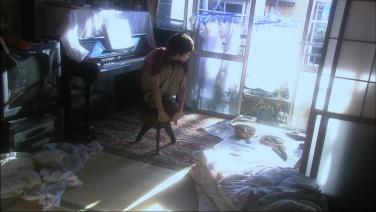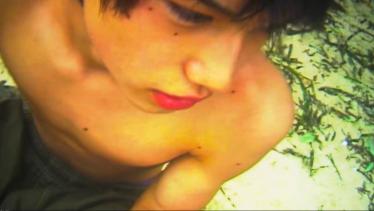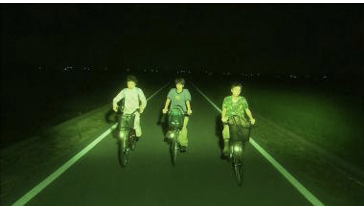1. Introduction
All About Lily Chou-Chou (2001), directed by Japanese filmmaker Shunji Iwai, stands as a landmark in early 21st-century Japanese cinema. Renowned for its fragmented narrative structure, lyrical visual language, and experimental cinematography, the film portrays the psychological landscape of adolescents growing up in a digitalizing society. The central concept of “Ether,” though ambiguous, functions as both a visual motif and a philosophical anchor throughout the narrative. Set against the backdrop of Japan’s early internet era, the film intertwines the virtual and physical worlds, presenting a generation trapped between emotional alienation and digital connection. Its dreamlike tone, nonlinear storytelling, and shifting perspectives challenge conventional cinematic norms and evoke a unique sensory and emotional experience.
While themes such as youth trauma, school bullying, and media alienation have been widely discussed, fewer studies have focused on how the film’s aesthetics contribute to its narrative power [1]. Moreover, the symbolic role of “Ether” is often referenced but rarely examined in depth through a visual and semiotic lens. This paper seeks to explore All About Lily Chou-Chou from the dual perspectives of cinematic aesthetics and film philosophy, with particular attention to how visual techniques shape meaning and how “Ether” functions as a semiotic and existential core.
2. Analysis of the film
2.1. Plot analysis
The film "All About Lily Chou-Chou" uses school bullying, which exists in the campus, as the main plot to drive its development. It also focuses on the growth of the protagonists and the reconstruction of idol worship and self-awareness in the Internet age that arrived at the beginning of the new millennium.
There are four main characters in this movie: Yuichi Hasumi, Shuya Tsukamoto, Shiori Satou, and Kuno. Black, white, and gray represent different facets of a character and different angles of characterization. Yuichi Hasumi, the male lead, has a complete growth arc throughout the film.
He starts as the bullied, then follows the orders of his bullies to harm others. After going through the departure of his friend and finally being unable to bear the oppression and deciding to fight back, he realizes that resistance can solve problems more straightforwardly than compliance. Thus, Yuichi Hasumi stands for "white".
Shuya Tsukamoto contrasts with Yuichi Hasumi. Having been bullied in the past, Shuya chooses to become a bully himself. Repeatedly oppressing and committing violence against others hasn't truly redeemed him. However, with the special backdrop of the movie set in 2000 Japan, the dawn of the Internet age, Shuya and Yuichi are friends in an online chat group created by Yuichi, and they even make an appointment to meet at Lily Chou-Chou's concert.
The film also depicts two female characters. They are subjected to inexplicable malice and bullying, which brings unendurable shocks and disruptions to their peaceful lives. Due to different life experiences and attitudes towards life, they have different endings, showing us varied images and fates. They also represent the vast majority of adolescents. Each character represents a certain group, and at the same time, they are individuals endowed with different meanings.
2.2. Cinema angle analysis
Most of the camera angles that appear most frequently throughout the film are tilted. Through presenting the pictures from extremely tilted perspectives in different directions, the movie seems to be guiding the audience. There are repeatedly emerging subtitles in the middle of the movie frames, as well as constantly flashing white glitches. The green light sources of flashlights and night vision goggles that appear abruptly without conforming to the visual logic, the overused high exposure, and the overly high saturation all contribute to magnifying the inner worlds of the characters with the film's lens language [2]. The deliberately created roughness and shakiness lay the foundation for the instability of this movie and the plot development, full of multiple changes in the characters' fates. This paper believes this, instead, enables the audience not to be fully immersed in the film, so that they can more calmly observe and understand the social issues the movie intends to reflect.
3. Cinematography: visible light
The cinematographer of this film is Noboru Shinoda. He used a large number of smoke pellets to visualize the light. His ultimate pursuit of natural light and the shooting technique of large-area backlighting led to large areas of overexposure in the highlights.
The overexposed sunlight (Figure 1), combined with a thin layer of mist, and the soft light filter in front of the lens, instead made me feel closer to the visual experience in my memory or even in my dreams (Figure 2). It makes me feel that he is pursuing an aesthetics of overexposed highlights. The character image is the main body of film narration. The film character image is different from that in literature; it is a visualized, moving image [3]. However, the photographic light also plays a crucial role in shaping the characters. Light can set the color tone of the film as well as the temperament and personality of the characters.
For example, there's a scene in the movie where a flashlight serves as the main light source. However, there are no proper images or sets in the frame to justify the existence of this flashlight source. What's more, it keeps shaking constantly. The green light it emits is very much like the infrared night-vision function of early DV cameras in the millennium (Figure 3). This creates an atmosphere of teenage adventure. Although it abandons rationality and can even be a bit distracting, I think it fits the movie's tone perfectly. In the film All About Lily Chou-Chou, Noboru Shinoda's shooting techniques give me the impression that he deliberately creates a rough look and keeps a deliberate distance from the characters. There are rather intense shakes and highly saturated colors, much like the visual effect of old home DVs. Therefore, the use of DV gives the whole movie an unstable psychological feeling, as if it could be disrupted at any time.



4. Camera angle
4.1. Expressions of loneliness in shots
In the frame, there are two slanting sides, endless rice paddies stretching as far as the eye can see, a vast expanse of green. A student in a white short-sleeved shirt stands in the broad rice field, his head hanging slightly. He holds a Walkman in his hand, listening to some muffled music. Teenagers are having a heated discussion about the pop star "Lily Chou-Chou" on the forum, pouring out their fanatical pursuits and inner sustenance. The protagonist, Yuichi Hasumi, is the founder of this forum. In reality, however, he is constantly bullied and taciturn. The sunlight shines down from the upper left of the picture. The movie begins with such an image, quiet and somewhat solitary (Figure 4).

4.2. Unbalance lens
The opening tilted shots break the traditional horizontal and vertical composition of the camera, accompanied by the constantly emerging posts, creating a sense of imbalance and unease. In this sense of imbalance, the audience can feel the loneliness deep in Yuichi Hasumi's heart. It also reveals Hasumi's introverted personality and his estrangement from the outside world from the side. The frequently used tilted composition also shows that Hasumi is addicted to Lily Chou-Chou's music, and that the confusion and bewilderment in his life have found solace in Lily Chou-Chou. Her music redeems him. Moreover, the lush green fields stand in sharp contrast to the barren fields where another male lead, Tsukasa Hoshino, is, which also hints at Hoshino's fate.
A large number of tilted shots only allow the audience to see the scene of Kuno being chased and the painful image of her being torn. This avoids the visual impact of cruel and violent scenes. The floating cotton wool and the shaking ceiling create a dizzy feeling for the audience, building a terrifying and panic-stricken atmosphere. Such crazy and cruel things happening to teenagers aged only fourteen or fifteen indirectly express the theme of the movie: the confusion, bewilderment, and pain of adolescents [4].

4.3. Tense camera expression
The shaky, tilted shots stir up a sense of despair in the audience, making them feel desperate and tense. Viewers can't help but worry about Kuno's fate, which evokes a strong sense of resonance. At the end of the film, after the tragedy, Yuichi begins to reflect and grow. He starts to reexamine himself and the world around him, searching for a real way out. At this stage, the composition of the movie gradually returns to calmness and stability. The colors on both sides become soft and warm, symbolizing Yuichi's inner growth and reflection. The director uses some steady and soothing shots to show the process of Yuichi rediscovering himself and finding his direction, as well as his expectations and hopes for future life. The composition also becomes more concise and lively. By presenting Yuichi's gradual journey of stepping out of the shadows and reclaiming himself, it implies his inner growth and transformation.

5. About“ether”
What exactly is the "ether" that runs through the whole film? In this paper, throughout the movie, after the characters are bullied or after they've done the bullying, there are always some beautiful scenes and free spaces as transitions. So the author believes the ether is a medium, diffused everywhere in the universe. Its existence can't be predicted, yet it can be perceived. The existence of the ether offers redemption to the bullied Yuichi, gives Shiori the courage to face the unbearable, gives Tsukasa a space to preserve his former self, and makes Kuno strong. I believe the ether represents our perception of beautiful things. Let me explain why I think the ether is our perception of beautiful things, taking the segment of Shiori as an example. After being bullied and after the bullies have had their way, there are always many beautiful and free long shots for transition. That's the protagonists' perception of the ether, as well as the process of them experiencing it. Take Shiori's part, for instance. When Shiori happens upon some people flying kites and joins them to feel the kites floating freely in the sky, she smiles so brightly. But in the very next second, the shot cuts, and Shiori is already lying in a pool of blood, with kites still flying in the sky and her phone charm hanging on the wire. The camera slowly zooms in, as if life is slipping away silently (Figure 7). She felt the ether, but she didn't want to lose it. Perhaps saying goodbye after a moment of happiness is also a kind of relief.

About the ether, people observe, discover, and are constantly searching for it. However, if we lose the ability to perceive beautiful things, what would be the meaning of life? Each of the protagonists in the movie has something they want to protect. But in the face of great confusion, escaping and conforming perhaps become the first choices, the easiest ways to change the status quo. The constantly trembling images, the precarious psychological defenses, are like a tottering building about to collapse, never to return [5].
6. The aesthetics of this film
In the film, the perception of beautiful things is mainly reflected in the following aspects:
The first beautiful thing is the depiction of natural scenes: Natural landscapes such as lush green rice paddies and vast fields appear frequently. For example, at the beginning, the protagonist stands in an endless rice paddy, bathed in sunlight. The expanse of green not only outlines a serene and beautiful rural scenery but also implies the purity and inclusiveness of the natural world. It becomes a haven for the character's heart, allowing the audience to feel the momentary comfort that the protagonist gains from being there. This is the initial touch of beautiful things.
The second beautiful thing is the incorporation of musical elements: The music of Lily Chou-Chou runs through the whole film like an invisible emotional bond. For a teenager like Yuichi Hasumi, who is constantly bullied, when the music plays, he can briefly escape from the cruel reality and immerse himself in the world constructed by the melody, with an intoxicated and relaxed expression on his face. This clearly shows that music, as a beautiful thing, brings him spiritual redemption and support.
The third beautiful thing is the capture of relaxing moments: During the intervals of bullying, there are interspersed relaxing moments such as flying kites and watching the clouds. For instance, Shiori laughs with the people flying kites, feeling the kites soaring freely. In that brief moment, the character forgets the surrounding pain and devotes herself wholeheartedly to this wonderful experience. The sincere smile on her face enables the audience to directly perceive this beauty.
The fourth beautiful thing is the highlighting through color atmosphere: At the end of the film, the composition returns to stability, and the color tone tends to be soft and warm. The warm colors replace the cold and depressing colors often seen in the early stage, suggesting that the haze in the protagonist's heart is gradually dissipating and that he/she begins to embrace the light in life. This also reflects the protagonist's new perception and acceptance of beauty from the side [6].
7. Conclusion
This thesis systematically explores the aesthetic characteristics presented in Shunji Iwai's All About Lily Chou-Chou, with a particular focus on dissecting the director's unique cinematic language system. Through semiotic interpretation of compositional techniques such as tilted framing and exposure manipulation, this study reveals how these elements construct a visual field suffused with a sense of alienation and poetic tension. With regard to the recurring concept of "ether" in the film, the analysis delves into its philosophical and existentialist dimensions, elucidating the symbolic function of this core imagery in narrating adolescent spiritual struggles. By doing so, the research offers a novel interpretive perspective for audiences to engage with the film's thematic concerns.
This study focuses on the film All About Lily Chou-Chou from aesthetic and semiotic perspectives but does not deeply engage with audience reception or cross-cultural interpretations. Future research could expand to explore how viewers from different cultural backgrounds perceive the film, or investigate how the concept of “Ether” evolves and is reinterpreted within contemporary digital media contexts.
References
[1]. Lanik, M. (2013). School System, Classroom Bullying and the Subsequent Trauma – a Strong Theme in Contemporary Cinema. Derived from: https: //fipresci.org/report/school-system-classroom-bullying-and-the-subsequent-trauma-a-strong-theme-in-contemporary-cinema/
[2]. Miyao, D. (2013). The Aesthetics of Shadow. Duke University Press
[3]. Metz, C. (2011). Language and cinema (Vol. 26). Walter de Gruyter.
[4]. Kracauer, S. (1997). Theory of film: The redemption of physical reality. Princeton University Press.
[5]. Agarwal, A. (2024). The effect of social media in identity formation in adolescence. World Journal of Advanced Research and Reviews, 2024, 23(03), 775-779
[6]. Qiu, Y. (2024). A Study of the Visual Aesthetics of Japanese Director Iwai Shunji’s Films. Interdisciplinary Humanities and Communication Studies. Vol. 1 No. 1: Issue 6
Cite this article
Zhu,Y. (2025). Aesthetic Analysis of All About Lily Chou-Chou. Communications in Humanities Research,76,37-43.
Data availability
The datasets used and/or analyzed during the current study will be available from the authors upon reasonable request.
Disclaimer/Publisher's Note
The statements, opinions and data contained in all publications are solely those of the individual author(s) and contributor(s) and not of EWA Publishing and/or the editor(s). EWA Publishing and/or the editor(s) disclaim responsibility for any injury to people or property resulting from any ideas, methods, instructions or products referred to in the content.
About volume
Volume title: Proceedings of ICADSS 2025 Symposium: Art, Identity, and Society: Interdisciplinary Dialogues
© 2024 by the author(s). Licensee EWA Publishing, Oxford, UK. This article is an open access article distributed under the terms and
conditions of the Creative Commons Attribution (CC BY) license. Authors who
publish this series agree to the following terms:
1. Authors retain copyright and grant the series right of first publication with the work simultaneously licensed under a Creative Commons
Attribution License that allows others to share the work with an acknowledgment of the work's authorship and initial publication in this
series.
2. Authors are able to enter into separate, additional contractual arrangements for the non-exclusive distribution of the series's published
version of the work (e.g., post it to an institutional repository or publish it in a book), with an acknowledgment of its initial
publication in this series.
3. Authors are permitted and encouraged to post their work online (e.g., in institutional repositories or on their website) prior to and
during the submission process, as it can lead to productive exchanges, as well as earlier and greater citation of published work (See
Open access policy for details).
References
[1]. Lanik, M. (2013). School System, Classroom Bullying and the Subsequent Trauma – a Strong Theme in Contemporary Cinema. Derived from: https: //fipresci.org/report/school-system-classroom-bullying-and-the-subsequent-trauma-a-strong-theme-in-contemporary-cinema/
[2]. Miyao, D. (2013). The Aesthetics of Shadow. Duke University Press
[3]. Metz, C. (2011). Language and cinema (Vol. 26). Walter de Gruyter.
[4]. Kracauer, S. (1997). Theory of film: The redemption of physical reality. Princeton University Press.
[5]. Agarwal, A. (2024). The effect of social media in identity formation in adolescence. World Journal of Advanced Research and Reviews, 2024, 23(03), 775-779
[6]. Qiu, Y. (2024). A Study of the Visual Aesthetics of Japanese Director Iwai Shunji’s Films. Interdisciplinary Humanities and Communication Studies. Vol. 1 No. 1: Issue 6









